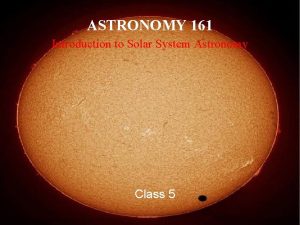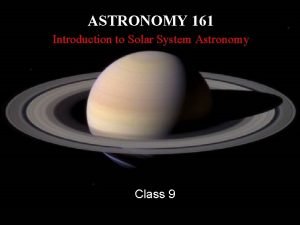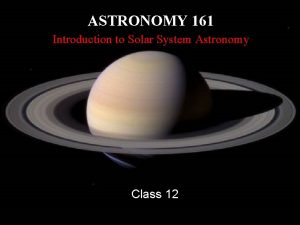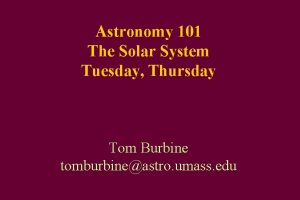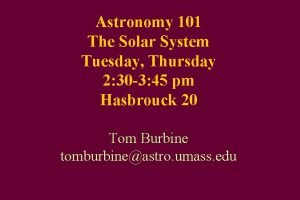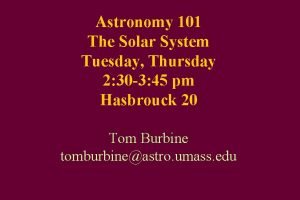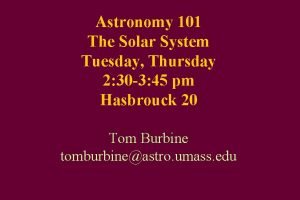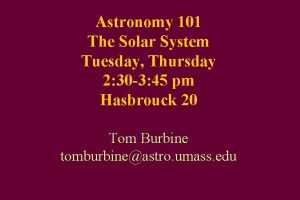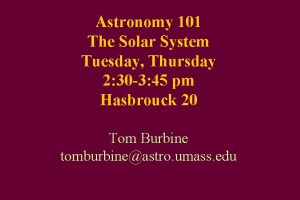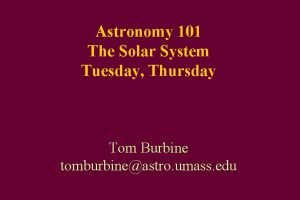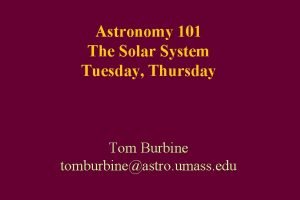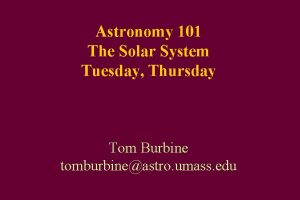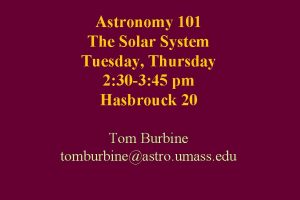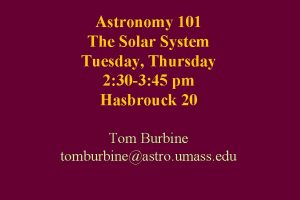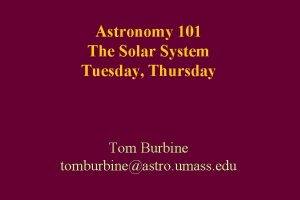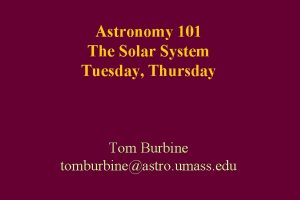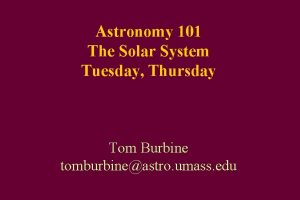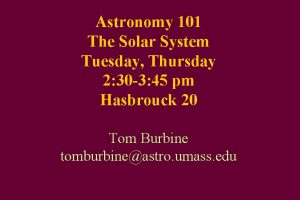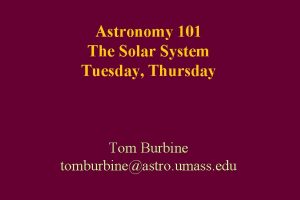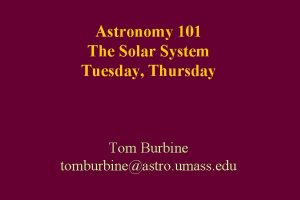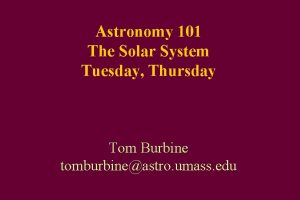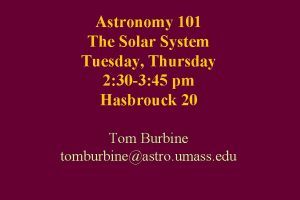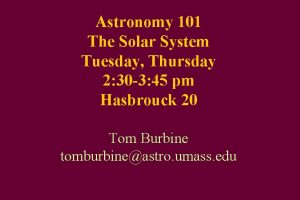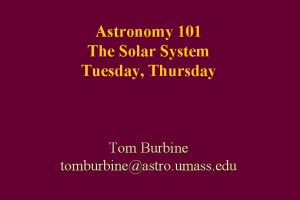Astronomy 101 The Solar System Tuesday Thursday 2






















- Slides: 22

Astronomy 101 The Solar System Tuesday, Thursday 2: 30 -3: 45 pm Hasbrouck 20 Tom Burbine tomburbine@astro. umass. edu

Course • Course Website: – http: //blogs. umass. edu/astron 101 -tburbine/ • Textbook: – Pathways to Astronomy (2 nd Edition) by Stephen Schneider and Thomas Arny. • You also will need a calculator.

Office Hours • Mine • Tuesday, Thursday - 1: 15 -2: 15 pm • Lederle Graduate Research Tower C 632 • Neil • Tuesday, Thursday - 11 am-noon • Lederle Graduate Research Tower B 619 -O

Homework • We will use Spark • https: //spark. oit. umass. edu/webct/logon. Display. d owebct • Homework will be due approximately twice a week • I will drop the lowest homework score.

HW #2, #3, #4 • I will go over the answers • http: //blogs. umass. edu/astron 101 -tburbine

Exam #1 • • • Review questions are online Thursday 40 questions Multiple choice and True/False Review session: – Wednesday 6 -7 pm in Hasbrouck 20

http: //www. hulu. com/watch/63319/cosmos-the-harmony-of-the-worlds

Acceleration • Acceleration is when your velocity is changing • Velocity not changing, no acceleration

Acceleration • • • a = ∆v/∆t Car is travelling at 10 m/s Increases its speed to 30 m/s over 5 seconds a = (30 m/s – 10 m/s)/5 seconds a = 4 m/s 2

Difference between mass and weight • Mass is the amount of matter in your body • Weight is the amount of force acting on your body • So on the Moon, you would have the same mass as on Earth but weigh less on the Moon since the Moon is less massive than Earth

Isaac Newton (1642 -1727) • Supposedly saw an apple fall to the ground • He then understood that gravity was universal, meaning it affected both the planets and us on Earth • Came up with 3 Laws of Motion

Force • Force – anything that can cause a body to change velocity

Newton’s st 1 Law • In the absence of a net (overall) force acting upon it, an object moves with a constant velocity • An object at rest remains at rest • An object in motion tends to remain in motion unless a force is acting upon it

Why do things on Earth not remain in motion?

Why do things on Earth not remain in motion? • Friction

Newton’s • • • nd 2 Law Force = mass x acceleration Units of Force kg m/s 2 = newton So much do you weigh Say your mass is 100 kg F = 100 kg x 9. 8 m/s 2 F = 980 Newtons

Newton’s rd 3 Law • For any force, there is an equal and opposite reaction force • Gravity is holding you on the ground • The ground is also pushing back up on you with the same amount of force

http: //www. vshiksha. com/system/files/u 1/pslvc 6 -rocket. jpg

Newton’s Universal Law of Gravitation • Every mass attracts every other mass through the force called gravity • Newton came up with this formula F = G M 1 M 2 r 2 M 1, M 2 are the masses of the two objects r is the distance between the objects G = constant = 6. 67 x 10 -11 m 3/(kg s 2)

So what should you know about this formula F = G M 1 M 2 r 2 • The force of attraction between any two objects is directly proportional to the product of their masses • The force of attraction between two objects decreases with the square of the distance between their centers • G is a very small number

What is the attraction of two people in this room? F = G M 1 M 2 r 2 • • • Say their masses are both 100 kg Their distances are 10 meters apart F = 6. 67 x 10 -11 m 3/(kg s 2) * 100*100 kg 2/(10*10 m 2) F = 6. 67 x 10 -9 N = 0. 000067 N Remember the person weighs 980 N

Any Questions?
 Monday tuesday wednesday thursday friday calendar
Monday tuesday wednesday thursday friday calendar Monday tuesday wednesday thursday friday saturday sunday
Monday tuesday wednesday thursday friday saturday sunday Sunday monday tuesday wednesday thursday friday saturday
Sunday monday tuesday wednesday thursday friday saturday Learning astronomy by doing astronomy activity 1 answers
Learning astronomy by doing astronomy activity 1 answers Learning astronomy by doing astronomy
Learning astronomy by doing astronomy Learning astronomy by doing astronomy
Learning astronomy by doing astronomy Solar system astronomy class
Solar system astronomy class Solar system astronomy class
Solar system astronomy class Solar system astronomy class
Solar system astronomy class Astronomy 101 formulas
Astronomy 101 formulas Solar cells wholesale
Solar cells wholesale What is an inexhaustible source of energy
What is an inexhaustible source of energy Thoughtful thursday morning message
Thoughtful thursday morning message Thursday night prayer
Thursday night prayer Holy thursday (songs of innocence)
Holy thursday (songs of innocence) Blessed holy thursday
Blessed holy thursday Holy thursday cartoon
Holy thursday cartoon How's the weather here
How's the weather here Have a terrific thursday
Have a terrific thursday Thursday bell ringers
Thursday bell ringers Easter traditions in great britain
Easter traditions in great britain Information on easter
Information on easter Monday question of the day
Monday question of the day






